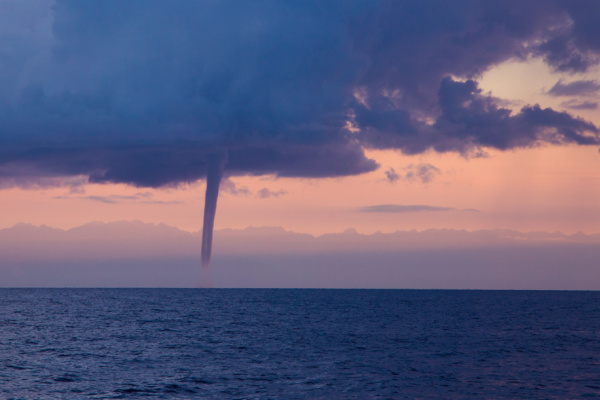The weather pattern across the Great Lakes and Northeast will suddenly switch from summerlike to brrrisk autumn conditions in the coming days. A November-like chill will sweep in and may even trigger snow in some places this weekend. AccuWeather meteorologists warn that the transition will be preceded by a dose of heavy rain and the risk of flash flooding in parts of the Northeast due in part to Tropical Storm Philippe.
Northeast Braces for Heavy Rains and Philippe
As AccuWeather reports, the sudden turn means heavy rain and flooding for some in the region. Showery rain and thunderstorms associated with a strong cold front will push from the central Great Lakes and much of the Ohio Valley on Thursday to the eastern Great Lakes and central Appalachians on Friday. From Friday night to Saturday, rain and thunder will pivot across the mid-Atlantic and southwestern New England.
The rain from the Midwest to the mid-Atlantic will bring the usual travel delays on the roads and at the airports, but where downpours persist, there is the potential for localized urban flash flooding. Right now, AccuWeather meteorologists don’t predict a repeat of the magnitude of flash flooding and chaos caused by torrential rain late last week in New York City.
However, AccuWeather forecasters do warn that the situation could escalate as the non-tropical system, Philippe, and another storm off the coast may try to merge. That would happen in northern and eastern New England late this weekend, causing the potential for flash flooding problems to increase and become widespread, dangerous and highly disruptive. Meteorologists urge people who live from Long Island to New England to keep close tabs on the forecast as the situation could escalate.
A 180 from Hot to Cold will Cause Chaotic Weather in the Midwest
The coldest air of the season yet will arrive across the Upper Midwest and Northeast from this weekend to early next week. Temperatures of 10-20 degrees Fahrenheit above the seasonal average will be swapped with temperatures of 10-20 degrees Fahrenheit below average in a matter of a few days.
The most impressive chill will be felt during the daytime hours. Highs will range from the 40s over the ridges and peaks of some of the mountains in the region to the upper 50s to near 60 along the East Coast and the Ohio River. In comparison, historical average highs range from the upper 50s over the northern tier of the Midwest and Northeast to the low to mid-70s along the Ohio River and the Chesapeake Bay region.
Water Spouts in the Great Lakes
Because Great Lakes waters will be much warmer than the air, relatively speaking, the air will become moist as it flows across the lakes, triggering extensive clouds and lake-effect rain showers. There can be isolated incidents of thunder and lightning where towering clouds build overhead. The chilly air and moisture will allow showers and angry-looking clouds to extend well away from the Great Lakes and into the central Appalachians.
AccuWeather meteorologists say this is an ideal setup for another autumn phenomenon on the Great Lakes. “The pattern will likely allow waterspouts to form on lakes Erie, Ontario and Michigan, especially from Sunday to Monday,” AccuWeather Senior Meteorologist Dave Dombek said. Water spouts are essentially a tornado over water.
The accompanying icy air and stiff winds will also create turbulent waves on the Great Lakes. The winds will tend to push some lake water toward the southern and eastern shorelines, where some overwash is possible this weekend to next week.
Frost and Snow for the Northeast?
Some places may even feel a brief taste of winter as the pattern shifts. “The air will get cold enough to allow wet snow or a mixture of rain and wet snow to fall on parts of southern Ontario and even into the higher elevations of the Adirondack Mountains of northeastern New York state from Sunday to Monday,” AccuWeather Senior Meteorologist Brett Anderson said. One to 3 inches of snow may accumulate on non-paved and elevated surfaces where it manages to snow hard for several hours, Anderson added.
Because of the extent of clouds and breezes around the clock, this pattern will not bring the lowest nighttime temperatures of the season yet to most places from the Great Lakes to the interior Northeast. Dry air, a clear sky and calm conditions at night allowed temperatures to dip into the 30s and 40s over the interior several weeks ago. Temperatures are likely to stop short of those levels in most cases.
However, new seasonal lows will be established along the East Coast and across portions of the Ohio Valley and central and northern Plains since winds ease and the sky becomes clear for several hours. As temperatures dip, the question of frost and freezes tends to arise, but the same clouds and breezy conditions will protect most areas from damage to tender crops and flowers.
There will be at least one zone with the potential for a frost since winds may weaken and skies may be clear enough for cold air to collect near the ground. “One area where there is some frost potential is in parts of Iowa, Missouri, Wisconsin, South Dakota and western Illinois,” Anderson said.
There are signs the cool weather pattern may have some staying power beyond a couple of days. This time, the chill may linger through much of next week in the Northeast and Great Lakes, with some moderation likely for the central and northern Plains to the Ohio Valley later next week.
—
Photo Credit: Karelian / Shutterstock.com
